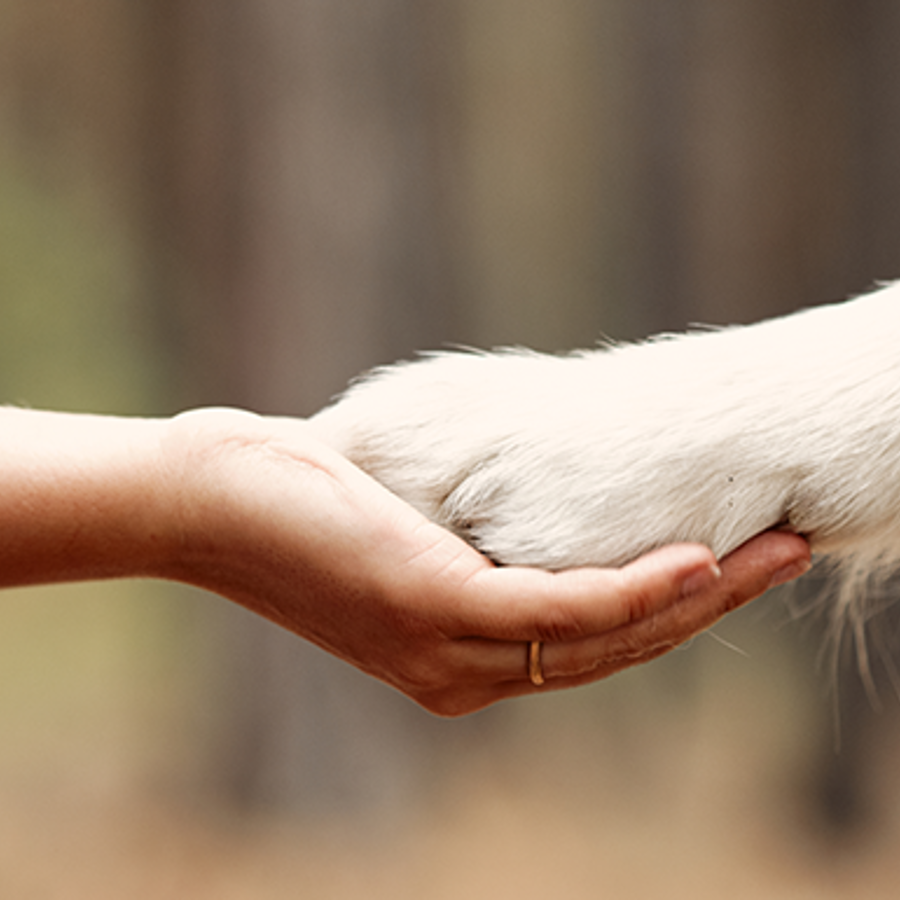
Why can’t humans and dogs have offspring?
July 29, 2015

- Related Topics:
- Speciation,
- Quirky questions,
- Chromosomes,
- Evolution,
- Reproduction,
- Developmental biology,
- Gene expression
A curious adult from New Jersey asks:
“Is it possible for humans and dogs to have offspring? I know it’s not but I want to show proof from a real geneticist so I can show it to someone. People believe anything without scientific research.”
Good question! You’re right, humans and dogs can’t reproduce.
So you won’t get anything like Barf the Mog from Spaceballs. A half man/half dog wouldn’t get very far past a single cell (assuming the egg and sperm could even come together!).
This is because dogs and people have very different sets of instructions in their DNA. Their genomes are simply too different to come together and make something that will live. Their genomes cannot mix in any productive way.
Imagine you take the instructions for making an airplane and instructions for making a curling iron and mix them together. If you use those mixed instructions it would be very unlikely you’d make a flying machine that curls your hair. Instead you’d most likely get a heap of metal that can’t do anything.
The idea is the same for how we can’t get a half man/half dog. The instructions are just too different to make anything meaningful.
To answer your question more scientifically, we’ll go over how our genomes work to see how human and dog genomes won’t work well together.
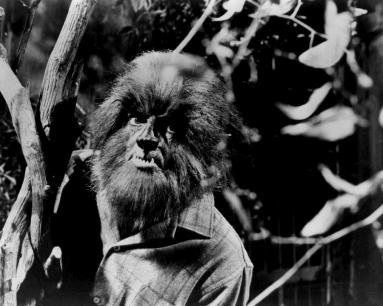
Genomes are Passed Down From Generation to Generation
Every living thing has a genome. This genome is like an instruction manual made up of individual instructions that scientists call genes. These instructions tell us what to have and make to be humans.
Each species has a genome that is unique, which is why people are people and dogs are dogs. For example, the human genome tells us to have two arms and two legs. Dog genomes tell dogs to have four legs, fur and tails.
As you can imagine, there is a lot of important information in the genome. Losing that information would be bad, so species evolved to organize the information into sections called chromosomes.
Just as each species has a unique genome, each species has a certain number of chromosomes. As a general rule, closely related species often have similar numbers of chromosomes, and distantly related species don’t.
For example, humans usually have 23 pairs of chromosomes, for a total of 46. Chimpanzees, which are closely related to humans, have 24. Dogs, which are not as related, have 39 pairs.
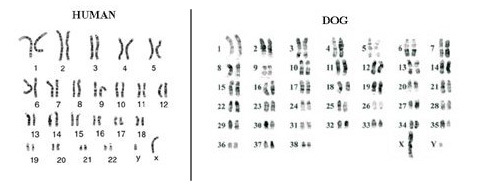
This is one reason explaining why Mogs aren’t walking around—chromosome number and organization are incredibly important as an embryo develops. And the genomes of dogs and people are just organized too differently.
One reason this is important is because of what happens when cells divide. Chromosomes need to line up and the right number needs to move to each new cell. This gets more and more difficult to pull off as the number gets more and more different. In the end, a dividing embryo would stop developing.
In addition to the general rule of chromosome number, scientists can tell how closely related species are by seeing how similar their genomes are to each other. So for example, humans’ closest living relation is the chimpanzee. Compared to other animals, chimpanzees have a genome that is most similar to ours.
Very closely related species can occasionally produce a hybrid offspring, or mix of the two species. This is even true in species where chromosome number is off by one or a few pairs. But there can be genetic consequences like the offspring being sterile as happens when a horse and a donkey make a mule.
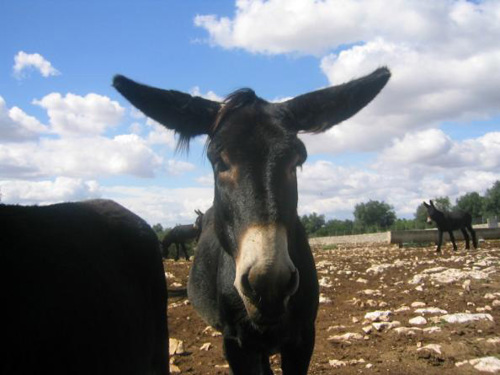
Even if dogs and humans had pretty close to the same number of chromosomes, they could still not produce anything Mog-like (any more than a sable antelope and a person could—they both have 23 pairs of chromosomes!). Their genomes are too different to mix and produce something that will live.
Now here’s a twist: many human genes and dog genes are actually pretty similar. But they still can’t combine to make a Mog.
It turns out there is more to your genome than genes. In fact, genes are regulated so that they are on or off at different times, and in different amounts. And this is really important for making a person a person, and a dog a dog.
Genes are Turned on and off by Transcription Factors
Imagine you want to make a grilled cheese sandwich. You’ve got your bread, butter, cheese and a pan. You don’t want to just toss all the stuff into the pan at the same time, right? You’d get a burnt, cheesy mess instead of a yummy sandwich.
Things have to happen in a specific order. Put the butter in the pan first, then make the sandwich, then put it in the pan, then flip it, et cetera.
Similarly, to make a person or a dog, everything needs to happen in a certain order. You need to have a head before you have hair, right? And fingers before you have fingernails!
To make sure this order happens the right way, genes get turned on and off in different amounts and in a very specific order by things called transcription factors. Transcription factors attach to genes to turn them on and off, a little or a lot.
When genes are turned on and off has a lot to do with why we can’t make Mogs. Even though human and dog genes are similar, they are not regulated the same. In other words, they’re turned on and off to different levels and at different times. This would be a really bad thing for a half human/half dog.
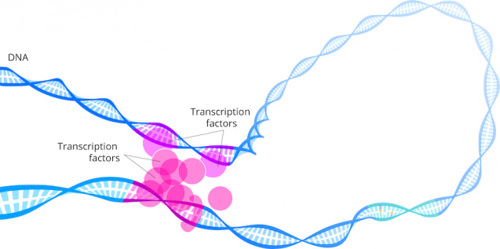
Let’s take limb development as an example. This is the set of genes that makes your arms and legs, or in the case of a dog four legs.
The genes themselves are pretty similar in dogs and people. What gives a dog four legs and a human two arms and two legs has more to do with which genes are turned on when and to what level.
This is important because in a half human/half dog situation, both of those orders of turning genes off and on would happen at the same time. You might think that having both of these orders at the same time would be fine—that maybe one would win, ending up with either two arms and two legs, or with four legs.
But that’s not likely to happen, because what the human and dog instructions would really be doing is competing with each other. The dog instructions for making limbs would prevent the human way from working right. And vice versa: the human instructions for making limbs would stop the dog way from working right.
So what would probably happen is that no limbs would be made at all, or the wrong number or location of limbs would be made because the human and dog instructions are competing with each other. And without limbs developing the right way, all development would stop and the developing embryo would die.
Limb development is just one (really important) example of how different regulation of genes in humans and dogs would prevent making a Mog. There are many, many other gene sets in humans and dogs that would act like this. For this reason, a half man/half dog wouldn’t get too far during development.
We won’t have any Mogs walking around, because even though human and dog genes are pretty similar, they are regulated in very different ways. The regulation of these genes would interfere with each other, preventing a half man/half dog from developing far beyond a few cells.

Author: Amanda Jacobson
When this answer was published in 2015, Amanda was a Ph.D. candidate in the Department of Microbiology & Immunology, studying bacterial infections and host immune responses in Denie Monack’s laboratory. Amanda wrote this answer while participating in the Stanford at The Tech program.
 Skip Navigation
Skip Navigation
